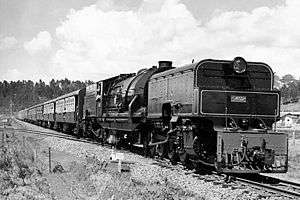KUR EC4 class
The KUR EC4 class, later known as the EAR 54 class, was a class of 1,000 mm (3 ft 3 3⁄8 in) gauge 4-8-2+2-8-4 Garratt-type articulated steam locomotives developed under and for use in wartime conditions.
| |||||||||||||||||||||||||||||||||||||||||||||||||
|---|---|---|---|---|---|---|---|---|---|---|---|---|---|---|---|---|---|---|---|---|---|---|---|---|---|---|---|---|---|---|---|---|---|---|---|---|---|---|---|---|---|---|---|---|---|---|---|---|---|
 EAR 5402 with a passenger train at Limuru, Kenya | |||||||||||||||||||||||||||||||||||||||||||||||||
| |||||||||||||||||||||||||||||||||||||||||||||||||
| |||||||||||||||||||||||||||||||||||||||||||||||||
| |||||||||||||||||||||||||||||||||||||||||||||||||
| |||||||||||||||||||||||||||||||||||||||||||||||||
| [1] | |||||||||||||||||||||||||||||||||||||||||||||||||
The seven members of the class were built during the latter stages of World War II by Beyer, Peacock & Co. in Manchester, England, for the War Department of the United Kingdom and the Kenya-Uganda Railway (KUR). They entered service on the KUR in 1944, and were later operated by the KUR's successor, the East African Railways (EAR).[2]
Class list
The builder's and fleet numbers of each member of the class were as follows:[3][4]
|
gollark: I suppose if you clone the beeoids enough then you won't have to worry about them.
gollark: I suppose you could ignore this.
gollark: MANY people considered this, but the issue is grudger incursions being activated by any 1 used in signalling.
gollark: It's probably easier in lisp because of the whole "everything is fairly simple expression trees" thing.
gollark: If they replicated faster but cooperated with each other it could work maybe.
See also
- Rail transport in Kenya
- Rail transport in Uganda
References
Notes
- Ramaer 1974, pp. 63–64, 70, 86, 88.
- Ramaer 1974, pp. 63–64.
- Ramaer 1974, pp. 63–64, 70.
- Durrant 1981, p. 196.
Bibliography
- Durrant, A E (1981). Garratt Locomotives of the World (rev. and enl. ed.). Newton Abbot, Devon, UK; North Pomfret, Vt, USA: David & Charles. ISBN 0715376411.
- Durrant, A E; Lewis, C P; Jorgensen, A A (1981). Steam in Africa. London: Hamlyn. ISBN 0600349462.
- Patience, Kevin (1976). Steam in East Africa: a pictorial history of the railways in East Africa, 1893-1976. Nairobi: Heinemann Educational Books (E.A.) Ltd. OCLC 3781370.
- Ramaer, Roel (1974). Steam Locomotives of the East African Railways. David & Charles Locomotive Studies. Newton Abbot, Devon, UK; North Pomfret, Vt, USA: David & Charles. ISBN 0715364375.
- Ramaer, Roel (2009). Gari la Moshi: Steam Locomotives of the East African Railways. Malmö, Sweden: Stenvalls. ISBN 9789172661721.
- Staff writer (June 1956). "The "54" Class Locomotives". East African Railways and Harbours Magazine. East African Railways and Harbours. 2 (9): 308. Retrieved 8 December 2014.CS1 maint: ref=harv (link)
External links
![]()
This article is issued from Wikipedia. The text is licensed under Creative Commons - Attribution - Sharealike. Additional terms may apply for the media files.